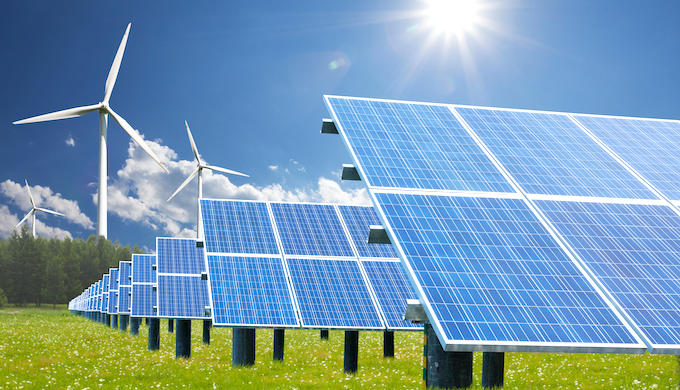Renewable power is surging despite the Covid-19 crisis and is on track to become the largest source of electricity by 2025, ending the dominance of coal, says the International Energy Agency

Renewable energy will overtake coal-fired electricity in five years (Photo by Alamy)
Global capacity addition of renewable energy will achieve new records this year and the next, even as fossil fuel capacity falls due to the economic slowdown brought on by the coronavirus pandemic, the International Energy Agency (IEA) said in a report.
In India, Covid-19 disruptions will cause a significant slowdown in 2020 photovoltaic deployment, but a strong rebound is expected in 2021 and 2022, the IEA said in its Renewables 2020 report.
New additions of renewable power capacity worldwide will increase to a record level of almost 200 GW this year, the IEA said, driven mainly by China and the United States. Wind and solar additions are set to jump by 30% in both the United States and China as developers rush to take advantage of expiring incentives.
“Renewable power is defying the difficulties caused by the pandemic, showing robust growth while other fuels struggle,” said Fatih Birol, executive director of IEA.
Even stronger growth is to come, the report predicted. India and the European Union will be the driving forces behind a record expansion of global renewable capacity additions of nearly 10% next year, the fastest growth since 2015, IEA said.
“This is the result of the commissioning of delayed projects where construction and supply chains were disrupted by the pandemic, and growth in markets where the pre-Covid project pipeline was robust,” it said.
India to be largest contributor
India is expected to be the largest contributor to the renewables upswing in 2021, with the country’s annual additions doubling from 2020, IEA predicted.
The South Asian country’s solar photovoltaic capacity additions will be one-third lower in 2020 than in 2019. In the first half of 2020, new solar capacity installations were 70% below average first-half growth of the previous three years.
This drop resulted from a combination of pandemic-related supply chain disruptions and construction slowdowns, as well as increased macroeconomic risks, the report said.
A rebound in photovoltaic deployment is expected for 2021 and 2022 in India, with capacity additions exceeding the 2019 level as delayed and new projects become operational, IEA predicted.

Source: IEA
Although investor interest remains strong in renewable energy projects in India, capital expenditure is likely to decline in 2020, according to Clean Energy Investment Trends by the CEEW Centre for Energy Finance (CEEW-CEF) and the IEA.
See: India needs more investments to meet renewables target
“The resilience and positive prospects of the sector are clearly reflected by continued strong appetite from investors,” Birol said.
India has set a target of 450 GW of installed renewables capacity by 2030. The country had installed capacity of 87 GW at the end of 2019, according to official data. It means project developers would need to install more than 30 GW every year from now to 2030 to reach the target.
“Reaching India’s renewable energy targets will require a considerable increase in the pace of installation,” said Lucila Arboleya, economic and financial analyst at IEA.
The IEA’s renewables report, released on Tuesday, pointed out that the Covid-19 crisis has compromised the financial viability of distribution companies (discoms). The financial instability of many discoms leads to delayed payments to generators, decreasing the profitability of existing projects and raising the level of risk perceived by potential developers and financial institutions, it said.
From January to June 2020, total overdue payments owed by discoms rose 28% for all electricity generators and 10% for renewable electricity plants. In May 2020, the federal government announced a loan programme to reduce overdue amounts owed to generators.
Structural solution needed
“Although it is expected to provide important relief to renewable energy developers, a structural solution is needed to ensure the sustainability of discoms to achieve faster photovoltaic growth,” the IEA said.
The electricity generated by renewable technologies will increase by 7% globally in 2020, the report estimates. This growth comes despite a 5% annual drop in global energy demand, the largest since the Second World War.
The report’s outlook for the next five years sees cost reductions and sustained policy support continuing to drive strong growth in renewable power technologies. Total wind and solar photovoltaic capacity are on course to surpass natural gas in 2023 and coal in 2024.
There would be cost reductions and sustained policy support that would continue to drive strong growth in renewable power technologies for the nest five years, IEA forecast. Total wind and solar photovoltaic capacity is on course to surpass natural gas in 2023 and coal in 2024.
“In 2025, renewables are set to become the largest source of electricity generation worldwide, ending coal’s five decades as the top power provider,” said Birol. “By that time, renewables are expected to supply one-third of the world’s electricity.”
For India, IEA’s forecast predicts stable annual capacity addition growth after 2022, resulting from declining solar installation costs, continuing auction programmes and improving conditions for distributed solar development. Annual capacity increases during 2023-25 could average 13 GW to 18 GW between the main and accelerated cases, the agency said.
“Achieving higher deployment will require that discoms financial stability improves, the full potential of distributed photovoltaic is unlocked, transmission grid constraints are eliminated, and land acquisition becomes simpler,” IEA said.

Trackbacks/Pingbacks